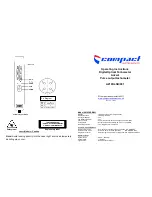
19
2.
Press TRANSPOSE
b
.
The pitch of the instrument is lowered one semitone and the amount
of transposition is displayed as a relative value for a short period.
(An eventual raised transpose setting will be lowered by one half-
step by pressing Transpose
b
).
* TRANSPOSE *
0 C = C
* TRANSPOSE *
-1 C = B
After about 5 seconds, if you don’t press either Transpose button,
the display returns to the previous situation and the instrument
remains at the last set pitch.
Every time you press the TRANSPOSE
b
button, the pitch is
lowered by one semitone.
The current Transpose setting remains memorized even after turning the
instrument off. When you turn the instrument on again, the LED of the
Transpose
b
or # buttons shown on indicate the lowered or raised status
of the pitch.
Reset
The current pitch setting can be cancelled instantly by pressing both
buttons together.
* TRANSPOSE *
0 C = C
This restores normal pitch to the instrument.
TOUCH
The RP100 offers three different keyboard responses, or “velocity curves”,
which affect the instrument as a whole. Every time you turn on the
instrument, the “NORMAL” curve is set automatically.
Two other curves are available: Soft and Hard.
Soft :
this is useful for a player with a lighter touch or some-
body more accustomed to a synth action keyboard. It
requires only a relatively soft touch to achieve maximum
volume.
Normal : This setting most accurately represents the touch re-
sponse of a piano.
Hard :
This setting is for “stronger” players. It requires a fairly
powerful touch to achieve maximum volume.
The various curves can be selected by repeatedly pressing either the
DATA + or – button after pressing the TOUCH button.
Summary of Contents for RealPiano RP150
Page 1: ...OWNER S MANUAL English...
Page 4: ...b...
Page 5: ...Instrument layout Section 1...
Page 64: ...60...
Page 65: ...61 Section 7 Reference...
Page 68: ...64...
Page 70: ...66...
Page 71: ...A 1 Appendix Appendice Anhang...
















































